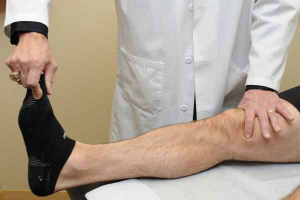The external rotation recurvatum test is the first test performed to evaluate a patient with potential posterolateral rotatory instability. In this test, the examiner determines if there is an increased amount of knee hyperextension compared to the contralateral side. The test is performed while applying a stabilizing force to the distal thigh while one lifts the great toe to assess the amount of knee recurvatum present. This is usually measured by the amount of heel height in cm. In general, it is measured on the medial aspect of the foot and compared to the contralateral normal knee.
Studies have demonstrated in the face of posterolateral knee injury, an increased amount of recurvatum is usually indicative of a combined anterior cruciate ligament tear.

